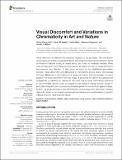Files in this item
Visual discomfort and variations in chromaticity in art and nature
Item metadata
| dc.contributor.author | Penacchio, Olivier | |
| dc.contributor.author | Haigh, Sarah M | |
| dc.contributor.author | Ross, Xortia | |
| dc.contributor.author | Ferguson, Rebecca | |
| dc.contributor.author | Wilkins, Arnold | |
| dc.date.accessioned | 2021-12-20T12:30:01Z | |
| dc.date.available | 2021-12-20T12:30:01Z | |
| dc.date.issued | 2021-12-20 | |
| dc.identifier | 276795125 | |
| dc.identifier | a5a9e1e2-3873-4bba-a2ba-ac80765fdc3c | |
| dc.identifier | 85122161731 | |
| dc.identifier | 000738868600001 | |
| dc.identifier.citation | Penacchio , O , Haigh , S M , Ross , X , Ferguson , R & Wilkins , A 2021 , ' Visual discomfort and variations in chromaticity in art and nature ' , Frontiers in Neuroscience , vol. 15 , 7111064 . https://doi.org/10.3389/fnins.2021.711064 | en |
| dc.identifier.issn | 1662-453X | |
| dc.identifier.uri | https://hdl.handle.net/10023/24544 | |
| dc.description | SH was supported by a NARSAD Young Investigator Grant from the Brain and Behavior Research Foundation (26282), an R15 AREA award from the National Institute of Mental Health (122935), an NSF EPSCoR grant (1632849) on which SH is a co-investigator, and the NIH COBRE PG20GM103650. OP was partially funded by a Leverhulme grant (RPG-2019-096) to Julie M. Harris and a Research Incentive Grant from the Carnegie Trust (RIG009298). | en |
| dc.description.abstract | Visual discomfort is related to the statistical regularity of visual images. The contribution of luminance contrast to visual discomfort is well understood and can be framed in terms of a theory of efficient coding of natural stimuli, and linked to metabolic demand. While colour is important in our interaction with nature, the effect of colour on visual discomfort has received less attention. In this study, we build on the established association between visual discomfort and differences in chromaticity across space. We average the local differences in chromaticity in an image and show that this average is a good predictor of visual discomfort from the image. It accounts for part of the variance left unexplained by variations in luminance. We show that the local chromaticity difference in uncomfortable stimuli is high compared to that typical in natural scenes, except in particular infrequent conditions such as the arrangement of colourful fruits against foliage. Overall, our study discloses a new link between visual ecology and discomfort whereby discomfort arises when adaptive perceptual mechanisms are overstimulated by specific classes of stimuli rarely found in nature. | |
| dc.format.extent | 11 | |
| dc.format.extent | 7850404 | |
| dc.language.iso | eng | |
| dc.relation.ispartof | Frontiers in Neuroscience | en |
| dc.subject | Visual discomfort | en |
| dc.subject | Efficient coding | en |
| dc.subject | Natural scenes | en |
| dc.subject | Image statistics | en |
| dc.subject | Colour | en |
| dc.subject | Chromaticity difference | en |
| dc.subject | Hypermetabolism | en |
| dc.subject | BF Psychology | en |
| dc.subject | RC0321 Neuroscience. Biological psychiatry. Neuropsychiatry | en |
| dc.subject | Neuroscience(all) | en |
| dc.subject | Psychology(all) | en |
| dc.subject | DAS | en |
| dc.subject.lcc | BF | en |
| dc.subject.lcc | RC0321 | en |
| dc.title | Visual discomfort and variations in chromaticity in art and nature | en |
| dc.type | Journal article | en |
| dc.contributor.sponsor | Carnegie Trust | en |
| dc.contributor.sponsor | The Leverhulme Trust | en |
| dc.contributor.institution | University of St Andrews. School of Psychology and Neuroscience | en |
| dc.identifier.doi | https://doi.org/10.3389/fnins.2021.711064 | |
| dc.description.status | Peer reviewed | en |
| dc.identifier.grantnumber | RIG009298 | en |
| dc.identifier.grantnumber | RPG-2019-096 | en |
This item appears in the following Collection(s)
Items in the St Andrews Research Repository are protected by copyright, with all rights reserved, unless otherwise indicated.

